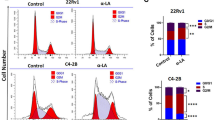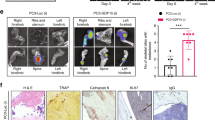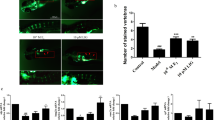Abstract
Background:
Treatment failure of prostate cancer (PCa) is often due to bone metastasis. Celastrol, an active constituent of Tripterygium wilfordii roots, has shown anti-tumor effects in previous studies in accordance with its indication in traditional Chinese medicine.
Methods:
Using a PC-3 cell model, in vitro assays were performed to evaluate the effects of celastrol on proliferation, migration (wound healing assay), tissues invasion (Transwell–Matrigel penetration assay) and vascular endothelial growth factor (VEGF) secretion (enzyme-linked immunosorbent assay). An intra-tibia injection mouse model was used to assess the effect of celastrol on PCa bone metastasis in vivo.
Results:
Pretreatment with celastrol significantly reduced proliferation of PC-3 cells in a dose-dependent manner and cell migration was much slower than in controls. Significantly fewer cells penetrated the gel-membrane after celastrol administration and their skeletal invasive ability was significantly reduced in a dose-dependent manner. Correspondingly, a significant, dose-dependent decrease in VEGF secretion was observed. In the in vivo mouse model, pretreatment with celastrol (8 μmol l−1) inhibited the tumorigenicity of PC-3 cells so that almost no bone invasion occurred as compared with control injections. Histological examinations using hematoxylin and eosin staining showed that tibiae injected with celastrol pretreated PC-3 cells retained their natural bone structure.
Conclusions:
Celastrol may have preventive potential against PCa bone metastasis.
This is a preview of subscription content, access via your institution
Access options
Subscribe to this journal
Receive 4 print issues and online access
$259.00 per year
only $64.75 per issue
Buy this article
- Purchase on Springer Link
- Instant access to full article PDF
Prices may be subject to local taxes which are calculated during checkout






Similar content being viewed by others
References
Bubendorf L, Schöpfer A, Wagner U, Sauter G, Moch H, Willi N et al. Metastatic patterns of prostate cancer: an autopsy study of 1,589 patients. Hum Pathol 2000; 31: 578–583.
Shah RB, Mehra R, Chinnaiyan AM, Shen R, Ghosh D, Zhou M et al. Androgen-independent prostate cancer is a heterogeneous group of diseases: lessons from a rapid autopsy program. Cancer Res 2004; 64: 9209–9216.
Chaffer CL, Weinberg RA . A perspective on cancer cell metastasis. Science 2011; 331: 1559–1564.
Monteiro J, Fodde R . Cancer stemness and metastasis: therapeutic consequences and perspectives. Eur J Cancer 2010; 46: 1198–1203.
Martin-Padura I, Gregato G, Marighetti P, Mancuso P, Calleri A, Corsini C et al. The white adipose tissue used in lipotransfer procedures is a rich reservoir of CD34+ progenitors able to promote cancer progression. Cancer Res 2012; 72: 325–334.
Weidner N, Carroll PR, Flax J, Blumenfeld W, Folkman J . Tumor angiogenesis correlates with metastasis in invasive prostate carcinoma. Am J Pathol 1993; 143: 401–409.
Ferrer FA, Miller LJ, Andrawis RI, Kurtzman SH, Albertsen PC, Laudone VP et al. Vascular endothelial growth factor (VEGF) expression in human prostate cancer: in situ and in vitro expression of VEGF by human prostate cancer cells. J Urol 1997; 157: 2329–2333.
Ferrer FA, Miller LJ, Andrawis RI, Kurtzman SH, Albertsen PC, Laudone VP et al. Angiogenesis and prostate cancer: in vivo and in vitro expression of angiogenesis factors by prostate cancer cells. Urology 1998; 51: 161–167.
Liu Z, Ma L, Zhou GB . The main anticancer bullets of the Chinese medicinal herb, thunder god vine. Molecules 2011; 16: 5283–5297.
Yang H, Chen D, Cui QC, Yuan X, Dou QP . Celastrol, a triterpene extracted from the Chinese ‘Thunder of God Vine,’ is a potent proteasome inhibitor and suppresses human prostate cancer growth in nude mice. Cancer Res 2006; 66: 4758–4765.
Dubrovska A, Kim S, Salamone RJ, Walker JR, Maira SM, García-Echeverría C et al. The role of PTEN/Akt/PI3K signaling in the maintenance and viability of prostate cancer stem-like cell populations. Proc Natl Acad Sci USA 2009; 106: 268–273.
Huang S, Peng L, Tang Y, Zhang L, Guo W, Zou X et al. Hypoxia of PC-3 prostate cancer cells enhances migration and vasculogenesis in vitro of bone marrow-derived endothelial progenitor cells by secretion of cytokines. Oncol Rep 2013; 29: 2369–2377.
Huang S, Tang Y, Cai X, Peng X, Liu X, Zhang L et al. Celastrol inhibits vasculogenesis by suppressing the VEGF-induced functional activity of bone marrow-derived endothelial progenitor cells. Biochem Biophys Res Commun 2012; 423: 467–472.
Peng X, Guo W, Liu T, Wang X, Tu X, Xiong D et al. Identification of miRs-143 and -145 that is associated with bone metastasis of prostate cancer and involved in the regulation of EMT. PLoS ONE 2011; 6: e20341.
Nolan DJ, Ciarrocchi A, Mellick AS, Jaggi JS, Bambino K, Gupta S et al. Bone marrow-derived endothelial progenitor cells are a major determinant of nascent tumor neovascularization. Genes Dev 2007; 21: 1546–1558.
Gao D, Nolan D, McDonnell K, Vahdat L, Benezra R, Altorki N et al. Bone marrow-derived endothelial progenitor cells contribute to the angiogenic switch in tumor growth and metastatic progression. Biochim Biophys Acta 2009; 1796: 33–40.
Rana A, Chisholm GD, Khan M, Sekharjit SS, Merrick MV, Elton RA . Patterns of bone metastasis and their prognostic significance in patients with carcinoma of the prostate. Br J Urol 1993; 72: 933–936.
Gao D, Nolan DJ, Mellick AS, Bambino K, McDonnell K, Mittal V . Endothelial progenitor cells control the angiogenic switch in mouse lung metastasis. Science 2008; 319: 195–198.
Davidoff AM, Ng CY, Brown P, Leary MA, Spurbeck WW, Zhou J et al. Bone marrow-derived cells contribute to tumor neovasculature and, when modified to express an angiogenesis inhibitor, can restrict tumor growth in mice. Clin Cancer Res 2001; 7: 2870–2879.
Pang X, Yi Z, Zhang J, Lu B, Sung B, Qu W et al. Celastrol suppresses angiogenesis-mediated tumor growth through inhibition of AKT/mammalian target of rapamycin pathway. Cancer Res 2010; 70: 1951–1959.
Paller CJ, Ye X, Wozniak PJ, Gillespie BK, Sieber PR, Greengold RH et al. A randomized phase II study of pomegranate extract for men with rising PSA following initial therapy for localized prostate cancer. Prostate Cancer Prostatic Dis 2013; 16: 50–55.
Perabo FG, von Löw EC, Ellinger J, von Rücker A, Müller SC, Bastian PJ . Soy isoflavone genistein in prevention and treatment of prostate cancer. Prostate Cancer Prostatic Dis 2008; 11: 6–12.
Acknowledgements
Dedicated to the memory of my friend and mentor Professor Dr Adolf Nahrstedt, Chair of Pharmacognosy at Münster University, Germany, who died on 7 January 2016 after a long battle with prostate cancer. This work was supported by the ‘Key Science and Technology Planning Project of Guangzhou’ Grant (2009A1-E031-3) and ‘Sino-Japanese scientific and technological cooperation program, MOST of China’ (No. 198-59).
Author information
Authors and Affiliations
Corresponding authors
Ethics declarations
Competing interests
The authors declare no conflict of interest.
Rights and permissions
About this article
Cite this article
Kuchta, K., Xiang, Y., Huang, S. et al. Celastrol, an active constituent of the TCM plant Tripterygium wilfordii Hook.f., inhibits prostate cancer bone metastasis. Prostate Cancer Prostatic Dis 20, 156–164 (2017). https://doi.org/10.1038/pcan.2016.61
Received:
Revised:
Accepted:
Published:
Issue Date:
DOI: https://doi.org/10.1038/pcan.2016.61
This article is cited by
-
Modulation of hypoxia-inducible factor-1 signaling pathways in cancer angiogenesis, invasion, and metastasis by natural compounds: a comprehensive and critical review
Cancer and Metastasis Reviews (2024)
-
Targeting autophagy in prostate cancer: preclinical and clinical evidence for therapeutic response
Journal of Experimental & Clinical Cancer Research (2022)
-
Phytochemistry of Prunus africana and its therapeutic effect against prostate cancer
Comparative Clinical Pathology (2022)
-
Zebrafish as an alternative method for determining the embryo toxicity of plant products: a systematic review
Environmental Science and Pollution Research (2018)



